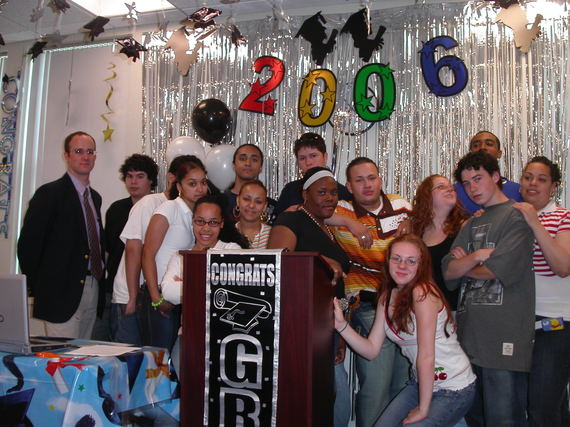"Why do I have to do this?"... "How do I know what I want my life to be like 14 years from now?"... "Come on! Shouldn't we be learning stuff?"... It was the first day of school in Providence, RI, August 2002 and already my group of 9th grade students were testing boundaries and asking tough fundamental questions.
One of the first activities that I had invited them to complete was to take 15 minutes to sit quietly imagining and writing about what they wanted their lives to be like 10 years after graduating from high school. As they settled into their still-unfamiliar seats and desks, gripping their ballpoint pens, hunched over their crisp loose-leaf paper scrawling out their hopes and dreams for the future, I observed eagerness, consternation, pride, and determination flitter across their faces.
Although I didn't allow it to show, I could empathize with the students who were raising objections to engaging in this activity. Why spend any precious instructional time daydreaming abstractly about a future that seemed so infinitely far away? The first day of high school was a prelude to a 4-year sprint with very measurable and immediate hurdles (homework assignments, presentations, standardized tests, college applications, etc.)
That future was actually not so far away - here we are!... As another school year begins, and we approach 2016, I recently saw a facebook post from one of those students: "We've got to start planning our reunion!" Indeed, this coming June will mark the 10th anniversary of their high school graduation, and in addition to the joy that we'll share in gathering together, I can't help but contemplate how to evaluate their success.
In the business sector, there are clear bottom lines: the profitability of companies is measured with a few generally mutually agreed upon metrics, such as Internal Rate of Return, Earnings Per Share, etc. Similarly, in the health care sector, there are certain statistics deemed as objective measures of individual and community well-being. However in education--as much as some like to create clearly defined algorithms for success--things are much more murky. Most might agree that an education system is successful when it equitably prepares each individual to thrive, flourish and positively contribute to their communities; however, controversy erupts when we discuss how to measure the efficacy of various approaches in reaching that goal.
We await, with bated breath, the outcomes of Capitol Hill legislative meetings that will ultimately inform what goes into the Every Child Achieves Act. However, it remains unclear whether the White House will approve it. One hopes that in their discussions policy makers consider not only the immediacy of dashboard-friendly data, but also longitudinal metrics that can better approximate long-term success, say, 10 years after high school. These policy-makers would do well consider recent evaluative revelations undertaken by both of the aforementioned health-care and business sectors.
For over 50 years, the United States federal health and nutrition guidelines asserted that the dietary intake of fat and cholesterol were direct contributors to a host of health problems. However, these commonly held beliefs have recently shown to be false; in fact, the Harvard School of Public Health has found that Eggs and Butter are not the guilty culprits they were so long accused of being. Thus, the federal government and health-care industry have gone about adapting their guidelines, rather than continue chasing short-term nutritional "successes."
Similarly, in the business sector, the bottom line may not be so clear after all. We need look no further than Amplify, of one of the largest business investments ever made in the education sector, and one of Newscorp's most catastrophic failures. Amplify's unraveling was reported just last month. But Harvard Business School professor (and--full disclosure--a member of my doctoral dissertation committee) Prof. Clayton Christensen perhaps foretold it three years ago in his Ted Talk:
The reason why successful companies fail is they invest in things that provide the most immediate and tangible evidence of achievement... The reason why it sums up to disaster, is that they are trying to maximize their profitability, and typically the way that you calculate profitability, tomorrow's investments that pay off tomorrow go to the bottom line, and are much more tangible than investments that pay of 10 years from now.
Professor Christensen concludes talk with a provocative proposal that he expands upon in his book, How Will You Measure Your Life? He suggests that the success of an individual's life could be measured by examining all of the interactions that individual had with other people and considering the extent to which that individual improved the lives of others.
- be happy and healthy
- get to spend time doing the things that I love and enjoy
- have a satisfying job and enough money to live on
- love and be loved by family members, friends, and community
I heard student after student repeat these ambitious goals. And as an educator I pondered what kinds of learning experiences would be the most valuable use of their time toward achieving these goals. Should they be prepared to master an AP heavy curriculum? Should they engage in internships in career areas that they wanted to explore? Should they dually enroll in college classes? In what ways could we connect their learning to their communities? How could we meet the students' expectations? And most importantly, how and when would we measure success?
As a nation, it behooves us to consider how we prioritize various learning experiences. As millions of high school students leap through the hoops and hurdles of the next 9 months of the school year, we must look beyond short-term gains in specific skills and knowledge toward their longer term needs and desires. Only then can we create a path toward effectively measuring success in their lives long after their graduation date. The outcomes of my students at the Met School in Providence, RI, have been tracked as a part of a unique longitudinal study across the network of Big Picture Learning schools that is ongoing, but has already yielded intriguing insights about the long-term value of internship experiences and structures that enable the formation of strong relationships.
It's now been nearly 14 years since I invited my students to envision what they wanted their lives to be like today. As the facebook posts about the reunion burble up with pulses of nostalgic excitement, building toward their planned 10th reunion festivities, I have been delighted to see that so many of them are happy and healthy, are engaged in careers and avocations that are great matches for them, and that they are attached to their family, friends, and community. They love, and are loved. By any measure, that is success.
--
Andrew Frishman worked closely with his advisory group of students from 2002 until their graduation in 2006 at the Met School in Providence, RI and is still closely connected with them. He is now the Co-Executive Director of Big Picture Learning.

